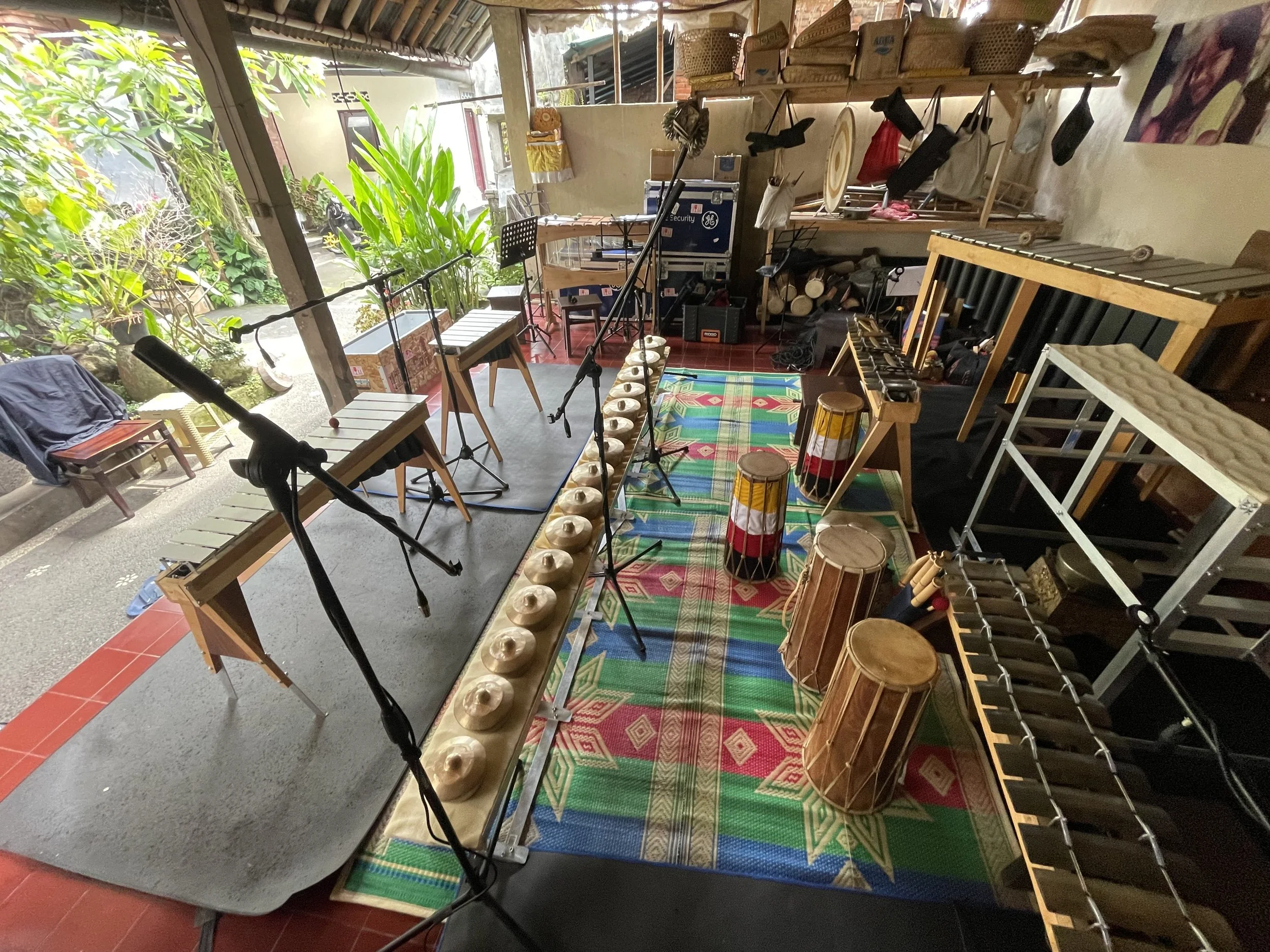Brian Baumbusch
Released by New World Records on May 26, 2023, Chemistry for Gamelan and String Quartet [80833-2], features three world premiere recordings of works by American composer and instrument designer Brian Baumbusch. Repertoire includes Prisms for Gene Davis for new gamelan instruments, Three Elements for String Quartet, and Hydrogen(2)Oxygen for new gamelan instruments and string quartet. The performing ensembles include Baumbusch’s longtime collaborators the JACK Quartet, as well as the Balinese ensemble Nata Swara, directed by Putu Septa and performing on two new sets of gamelan-inspired instruments designed and constructed by Baumbusch between 2011-2021.
A pick for KGNU’s Top Ten Albums of 2023.
Bio.
Composer, instrument designer, and musicologist Brian Baumbusch’s work, while innovative within the global contemporary music community, is deeply in dialogue with cross-cultural exchanges. Born April 23rd, 1987, Baumbusch centers his compositional work on developing alternative acoustics paradigms through the creation of new instruments and tuning systems, and originating new performance practices that feature computer-assisted live performance and recording projects in order to achieve performances of inconspicuously complex polytempo music.
Between 2007 and 2010, Baumbusch was deeply engaged in ethnomusicological field work centered on Argentine-Quechua folklore music. From 2012 to the present, Baumbusch has collaborated with several of Bali’s leading performing ensembles, and his works have premiered at the Bali Arts Festival.
At the advent of the COVID-19 pandemic, Baumbusch began creating new compositions that performers could collaborate on remotely by recording in isolation to individualized click tracks in order to cooperatively create complex polytempo structures. These include the symphonic length Isotropes, recorded by roughly 150 musicians between 2020 and 2021, and the evening length Polytempo Music, designed as a VR experience where the listener can interact with the music in an immersive 3D spatial audio-visual environment.
Baumbusch's work has been supported by the National Endowment of the Arts, the Smithsonian Institution, the Wallace Alexander Gerbode Foundation, the Walter and Elise Haas Fund, and New Music USA, among others.
About the Album
The contents of this album date back to twelve years ago, when American composer Brian Baumbusch began building new percussion instruments inspired by the Balinese gamelan – his “Gen 1” instruments – following in the footsteps of his West Coast predecessor Lou Harrison. Since then, Baumbusch has progressively deepened his relationship to Balinese music while also envisioning new performance practices of gamelan music through innovative instrument building designs, showcased in his “Gen 2” instrument set built between 2016-2021. With the help of New World Records, Baumbusch donated both instrument sets to the Balinese ensemble Nata Swara at the beginning of 2022, shipping 1800lbs of cargo from San Francisco to Bali and then traveling there himself to record the works presented on this album.
By donating his instruments to Nata Swara and its leader, Putu Septa, Baumbusch’s intention was to foster what Oscar Smith, author of the album liner notes, calls “an ongoing symbiotic cross-cultural collaboration,” offering new ideas and physical resources to Balinese artists and reinvigorating the longstanding cross-cultural exchange between Indonesia and the West dating back to Debussy and the Paris Exposition of 1899. Baumbusch has been experimenting for a decade with stretching the temporal aspects of music beyond the edges of human perception, a concept that Oscar Smith refers to in the album’s liner notes as “polytempo.” Some of his works, including Hydrogen(2)Oxygen and Three Elements for String Quartet, even require that the performers use individual click tracks in order to execute the multiple simultaneous time streams in the music. In collaboratively engaging with Nata Swara, Baumbusch suspected, correctly, that the deep training and inherently musical culture of the Balinese musicians might make them uniquely suited to execute these rhythmic challenges. Smith explains:
“Because of 1) the high frequency of music-making in the lifestyle of the Balinese ritual calendar; 2) the holistic conceptions of musical structures learnt by playing the tightly organized strata of Balinese traditional music; and 3) the social unity created by Balinese musicians’ collectivist sensibilities and its power to strengthen their ensemble performance; these players have developed the musicianship to perform Baumbusch’s music with near-perfect synchrony and sensitivity.”
Prisms for Gene Davis was commissioned in 2018 by Munich’s International Gamelan Festival. Premiered initially in Germany, the piece was later expanded and the full work premiered in Bali in 2022. It is performed on Baumbusch’s Gen 2 gamelan instruments. The work has one foot in minimalism and the other in Balinese music. The latter is especially noticeable in the time scales of the musical patterns, which are far longer than many minimalist composers have ventured to create.
Three Elements for String Quartet (2016) was commissioned by Composers Inc. through the Matthew Paul Finnigan Award and is one of Baumbusch’s earliest examples of composing with polytempo structures. The performers use individual click tracks in the first and third movements to make possible the execution of the polytempo relationships in the music, but in the middle movement the ensemble is free from “clock time” and can interpret the rhythms communally.
Hydrogen(2)Oxygen was composed in 2015 on a commission from the Smithsonian Institution and premiered by the Lightbulb Ensemble, playing the Gen 1 instruments, along with the JACK Quartet. The work allows the sound worlds of the string quartet and gamelan to exist side-by-side, exploiting their combinations and contrasts for expressive effect. The piece also uses polytempo rhythmic relationships; in the first movement, this results in vertical relationships so complex that they resist conventional notation, such that Baumbusch’s “score” of the piece is a time/tempo graph. Stephen Brookes, reviewing the world premiere of Hydrogen(2)Oxygen for the Washington Post, said the piece “built from an ethereal opening into a raging torrent of asymmetrical rhythms, phase-shifting patterns and beautifully strange harmonies. … Bewildering at first, even overpowering, it turned maddeningly beautiful and — to these ears, at least — magnificent, and as intoxicating as a drug.”



